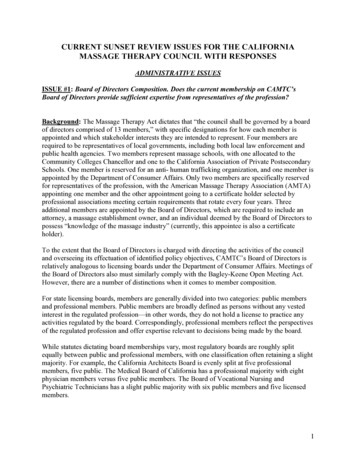
Transcription
CURRENT SUNSET REVIEW ISSUES FOR THE CALIFORNIAMASSAGE THERAPY COUNCIL WITH RESPONSESADMINISTRATIVE ISSUESISSUE #1: Board of Directors Composition. Does the current membership on CAMTC’sBoard of Directors provide sufficient expertise from representatives of the profession?Background: The Massage Therapy Act dictates that “the council shall be governed by a boardof directors comprised of 13 members,” with specific designations for how each member isappointed and which stakeholder interests they are intended to represent. Four members arerequired to be representatives of local governments, including both local law enforcement andpublic health agencies. Two members represent massage schools, with one allocated to theCommunity Colleges Chancellor and one to the California Association of Private PostsecondarySchools. One member is reserved for an anti- human trafficking organization, and one member isappointed by the Department of Consumer Affairs. Only two members are specifically reservedfor representatives of the profession, with the American Massage Therapy Association (AMTA)appointing one member and the other appointment going to a certificate holder selected byprofessional associations meeting certain requirements that rotate every four years. Threeadditional members are appointed by the Board of Directors, which are required to include anattorney, a massage establishment owner, and an individual deemed by the Board of Directors topossess “knowledge of the massage industry” (currently, this appointee is also a certificateholder).To the extent that the Board of Directors is charged with directing the activities of the counciland overseeing its effectuation of identified policy objectives, CAMTC’s Board of Directors isrelatively analogous to licensing boards under the Department of Consumer Affairs. Meetings ofthe Board of Directors also must similarly comply with the Bagley-Keene Open Meeting Act.However, there are a number of distinctions when it comes to member composition.For state licensing boards, members are generally divided into two categories: public membersand professional members. Public members are broadly defined as persons without any vestedinterest in the regulated profession—in other words, they do not hold a license to practice anyactivities regulated by the board. Correspondingly, professional members reflect the perspectivesof the regulated profession and offer expertise relevant to decisions being made by the board.While statutes dictating board memberships vary, most regulatory boards are roughly splitequally between public and professional members, with one classification often retaining a slightmajority. For example, the California Architects Board is evenly split at five professionalmembers, five public. The Medical Board of California has a professional majority with eightphysician members versus five public members. The Board of Vocational Nursing andPsychiatric Technicians has a slight public majority with six public members and five licensedmembers.1
Prior to 2014, CAMTC’s Board of Directors was much larger, with nineteen total members. Themembership composition also had substantially more professional representatives, with twomember appointments allotted to each qualified professional association—seven professionalmembers in total. Following the council’s sunset review, the Board of Directors wasreconstituted and generally reduced in overall size to its current form through the enactment ofAssembly Bill 1147. The bill substantially lowered the number of professional members, in partby clarifying that only California-based associations were eligible for an appointment.CAMTC’s Board of Directors does not expressly distinguish between professional and publicmembers; most of its membership categories are comprised of appointing authorities, and onlyone member is expressly required to be “a member of the public,” which is the memberappointed by the Director of Consumer Affairs. There is otherwise nothing prohibiting othermembers of the Board of Directors from being active certificate-holders. Meanwhile, only twomembers are expressly required to be massage professionals—the AMTA representative and theprofessional association appointee.There are potential downsides to increasing professional representation on a regulatory board. In2015, the United States Supreme Court ruled in North Carolina State Board of Dental Examinersv. Federal Trade Commission (“NC Dental”) that when a state regulatory board features amajority share of active market participants, any allegedly anticompetitive decision-making maynot be subject to Parker antitrust litigation immunity unless there is “active state supervision” toensure that all delegated authority is being executed in the interest of the public and not theprivate commercial interests of the members. This has led many to believe that boards are betterserved by having a public member majority.Nevertheless, clear delineations of public and professional board memberships offer a number ofbenefits. A relatively equal division of the categories provides for a balance of perspectives.While members of the public are presumably more independent and are more likely to prioritizethe interests of the consumer in their decision-making, professional members offer moreexpertise and can often provide valuable insight into questions of whether a licensee’s actionswere reasonable or appropriate. CAMTC’s Board of Directors may then benefit from havingmore of its members specifically reserved for representatives of the profession, as well as havingmore board positions expressly reserved for disinterested members of the public.Staff Recommendation: The council should provide the Committees with informationregarding how its Board of Directions currently functions and whether it believes any changesto member composition would better empower its governance, particularly in regards toclearer designation of public and professional memberships.CAMTC Response: When the Board was restructured in 2015, the big issue Department ofConsumer Affairs (DCA) boards were facing was that they were dominated by the industry thatthey regulated, and were not getting input from the public that they served. There was an overallconcern that industry controlled the regulatory boards too much. This is the backdrop that wasoccurring when the California Massage Therapy Counsel’s (CAMTC) Board composition waschanged to its current structure. The Legislature very carefully and thoughtfully created a2
properly balanced Board that includes both industry as well as non-industry appointments andhas made sure that there is not a majority of industry appointments for the Board. They weremindful of the legal issues tied to Board appointments when the statute was changed.CAMTC Board meetings are held regularly, proper notice of meetings is given in accordancewith Bagley-Keene’s notice requirements, discussions between Board members are robust, andmassage therapists, massage businesses, massage schools, and cities and counties in Californiaare heard and provide expertise related to the profession. A broad coalition of interests arerepresented on CAMTC’s Board, which in turn provides a diverse number of both informed andvaried points of view.CAMTC currently has a broad range of representatives from different entities and interests onthe Board, which results in policies supporting safe, legal, and efficacious massage. Themajority of CAMTC’s members would generally be considered to be “public members” as theyare non-industry members who each bring important expertise in their own related areas to theBoard. These non-industry members are appointed by the following entities: 1. League ofCalifornia Cities; 2. California State Association of Counties; 3. California Police ChiefsAssociation; 4. Anti-Human Trafficking Organization; 5. Director of the Department ofConsumer Affairs (appointee specifically designated to be a member of the public); 6. PublicHealth Official representing a city, or county; and 7. An attorney representing a city in the State.Five members are appointed by entities that represent the industry and they each provide neededexpertise from the profession to the Board: 1. Office of the Chancellor of the CaliforniaCommunity Colleges; 2. California Association of Private Postsecondary Schools; 3. AmericanMassage Therapy Association (the appointee must be a Certificate Holder); 4. A rotating seat fora massage professional appointed by a society, association, or other entity with a membershipcomprised of massage therapist professionals (appointee must be a Certificate Holder); and 5. Anindividual representing a massage business entity. This accounts for 12 of the Board’s 13members. The last member, depending on who is appointed, can either represent the industry ornot, because this individual must be someone who either provides “knowledge of the massageindustry or can bring needed expertise to the operation of the council for purposes of complyingwith Section 4603,” which states that CAMTC’s mission is to protect the public. (Bus. & Prof.Code §4602(f)(11) (italics added).) Currently, this seat is filled by a CAMTC Certified MassageTherapist, which means the current Board composition is 6 industry representatives on a 13member Board, 5 of whom are CAMTC Certified Massage Therapists, resulting in a properlybalanced Board that does not create the kinds of issues identified in the U.S. Supreme Courtdecision in North Carolina State Board of Dental Examiners v. Federal Trade Commission.ISSUE #2: Director Term Limits. Should members of the Board of Directors be authorized toserve indefinitely?Background: Statute provides that “board member terms shall be four years” for CAMTC’sBoard of Directors. However, it does not place any limitation on the number of terms that amember may serve. Additionally, it is not clearly stated that a board member must vacate theirposition following the completion of their term unless reappointed, nor is there any specific3
grace period provided. Instead, CAMTC appears to have interpreted the four year term languageto refer to when appointing authorities should be expected to either reappoint their representativeor identify a replacement.Meanwhile, some members have persisted beyond their four-year terms without expressreappointment. CAMTC states that this is authorized not specifically by the Massage TherapyAct but through provisions in the Corporations Code generally governing board memberships fornonprofit benefit corporations. Corporations Code § 5220 states that “unless otherwise providedin the articles or bylaws, each director, including a director elected to fill a vacancy, shall holdoffice until the expiration of the term for which elected and until a successor has been electedand qualified, unless the director has been removed from office.” This would appear to allowmembers to remain on the board indefinitely as long as a new member is not identified after fouryears, even without any formal reappointment.A limit to the number of terms that a member of CAMTC’s Board of Directors may serve wouldalign the Massage Therapy Act with other boards under the Department of Consumer Affairs,and potentially allow for fresher and more diverse perspectives on the board, where many haveserved for a decade or more. However, there is also an argument to be made that institutionalmemory has served CAMTC valuably, and that there is no compelling reason to requiremembers to step down. Nevertheless, it may still be reasonable to expressly requirereappointment of a member when their term of four years has expired, while potentially allowingfor a statutory grace period.Staff Recommendation: The council should provide its perspective on whether statute shouldmore clearly restrict the terms of members of the Board of Directors.CAMTC Response: Appointing entities are always free to appoint new and different memberswhen their appointee’s term expires or a Board member resigns. All Board members areengaged, regularly attend meetings, and voice their opinions on all of the issues presented.Those with previous experience on the Board bring a depth of knowledge that benefits allindividuals while new members bring different points of view. From a legal standpoint, theCalifornia Corporations Code does not require term limits for directors on a nonprofit publicbenefit corporation Board. CAMTC’s Board is currently functioning at a high and engagedlevel, therefore CAMTC does not believe that any changes to its terms or term limits arenecessary or appropriate at this time.ISSUE #3: Staff Compensation. Is the financial compensation for CAMTC’s Chief ExecutiveOfficer inappropriately high compared to leadership at other regulatory entities?Background: As a private nonprofit corporation, CAMTC’s employees are not subject to civilservice requirements and the Board of Directors has broad discretion to make hiring decisionsand set compensation. It has been previously pointed out that CAMTC’s CEO receives asubstantial salary. The issue was first raised in CAMTC’s 2014 sunset review background paper,which pointed to 2012 when the council’s CEO had earned 260,000 per year. In 2019,4
CAMTC’s CEO received compensation and benefits totaling 346,611, which may increase upto 8 percent per year with the Board’s approval.While nonprofits are generally authorized to grant compensation to its executives deemed“reasonable” by the Internal Revenue Service (IRS), the question of whether salaries provided byCAMTC are excessively generous is meaningful given that the entirety of the council’s budget isderived by fees, included those collected from certificate holders. In response to the inquiry,CAMTC commissioned a “CEO Compensation Study” in 2019. This study found that the totalcash compensation provided by CAMTC—which the study identified as 369,048—was justover the 25th percentile compared to similar nonprofit executives. As a result, the Board ofDirectors adopted a new compensation policy in 2019 to prohibit the CEO’s total compensationpackage from exceeding the 75th percentile for peer groups identified by the study over thecourse of the agreement or eroding the council’s three-month reserve.However, further examination of the study reveals what could be considered major flaws in itscomparative analysis. The study identified a number of nonprofit organizations as “peer groups”to whom CAMTC should be compared in terms of executive compensation; however, virtuallynone of these organizations could be considered regulatory entities, but are instead primarilyprofessional and trade associations such as the California Chamber of Commerce, the CaliforniaMedical Association, and the California Restaurant Association. Using these organizations aspeer groups resulted in the study determining that the cited 75th percentile mark would beapproximately 705,000 per year.As a more direct comparison, the Department of Consumer Affairs also commissioned a salarystudy in 2019 to analyze compensation trends among regulatory board Executive Officers (EOs).That study found that the median salary for an EO is approximately 107,000 per year, with thehighest paid EO at the time making 146,000 per year. If the CEO of CAMTC is moreaccurately compared to the EO of a regulatory board than a trade association, then the council’sexecutive compensation is well over three times the median salary of its peers.Staff Recommendation: The council should explain why it believes its executivecompensation represents a reasonable expenditure of certificate fee revenue.CAMTC Response: The Board has always been cognizant of the importance of setting up atransparent CEO compensation policy that is deemed reasonable by the IRS.The Board engaged experts to ensure that we comply with IRS restrictions and that weabsolutely don’t over pay, but that we pay fair compensation which is sufficient to retain a verywell qualified CEO. The CEO compensation study highlights why the CEO’s compensation isboth appropriate and reasonable. In the study, CBIZ looked to other massage related entitiessuch as the Federation of State Massage Therapy Boards and the American Massage TherapyAssociation as part of the peer review comparison process, along with other appropriate peerorganizations.5
As part of their market pricing methodology, the consultants examined non-profit peer data andCAMTC’s organizational scope. Special consideration was given to the organization’s size basedon total staff. CAMTC’s total staff of 62 was in the range of the median total staff of the peerorganizations (median number of staff for peer organizations was 60). The peer organizationsinclude eight smaller organizations as well as the Federation of State Massage Therapy Boards(FSMTB), which represent 46 regulatory Boards and the American Massage TherapyAssociation (AMTA).Both FSMTB and AMTA generate their revenues from fees massage therapists pay for examsand membership dues, respectively. An examination of AMTA’s IRS publicly available filingsreveals that in 2018 massage therapists who are AMTA’s members paid the Executive Director,who is located in Evanston, Illinois, 486,064, which is the equivalent to 802,005 afterfactoring in the cost of living differential between Chicago and Los Angeles. In the same year,CAMTC’s CEO earned 332,887.Unlike government employees that enjoy generous pensions with lifetime payments of a highpercentage of their salaries and lifetime health benefits, CAMTC’s employees, including theCEO, have worked without any healthcare or retirement benefits for the last ten years. Until2020, CAMTC’s employees, including the CEO, had to buy their own health care with after taxincome. A limited retirement plan was first funded in 2021. CAMTC’s Board compensationpolicy meets with the IRS’s rules regarding nonprofit organizations salary and benefits.In 2019, CAMTC’s CEO was provided with no benefits and his “compensation” includedreimbursement for regular employee expenditures (such as a phone and other forms oftechnology necessary to perform his job) as well as a monthly stipend to cover expenditures suchas health insurance and retirement, which therefore makes his monetary compensation lookunfairly inflated by comparison. The study for State EO’s failed to account for a full benefitspackage given to State workers, including the extremely generous retirement package whichincludes a high level of base pay and payment of health benefits, both for the lifetime of a retiredEO.CAMTC’s CEO must possess the ability to build and operate a free standing self-sustainedorganization that receives no support from a governmental infrastructure. The skill set, andexperience needed for CAMTC top leadership are fundamentally different from Department ofConsumer Affairs’ regulatory board Executive Officers.ISSUE #4: Public Records Act. Should CAMTC be required to comply with the requirementsof the California Public Records Act?Background: While the Massage Therapy Act is clearly intended to provide CAMTC withregulatory responsibilities analogous to a state government body, it is established in statute as aprivate nonprofit and is therefore not necessarily required to comply with various laws aimed atensuring transparency and accountability within state bureaucracy. This was arguably in part thelegislative intent of the nonprofit model, as it allows for more flexibility and efficiency. Statutedoes provide that meetings of CAMTC’s Board of Directors must comply with the provisions of6
the Bagley-Keene Open Meeting Act. However, many other similar laws and public oversightmechanisms do not necessarily apply to the council’s operations.The California Public Records Act (CPRA) generally provides that “public records are open toinspection at all times during the office hours of the state or local agency and every person has aright to inspect any public record.”16 The CPRA defines “state agency” for purposes of the Act as“every state office, officer, department, bureau, board, and commission or other state body oragency, except those agencies provided for in Article IV (except Section 20 thereof) or ArticleVI of the California Constitution.” This language is significantly less broad than the definition of“state body” provided in the Bagley-Keene Open Meeting Act and almost certainly does notinclude a private nonprofit like CAMTC. This is supported by caselaw; in California StateUniversity v. Superior Court (2011), the court found that CSU auxiliary organizations, which areprivate nonprofit corporations operating pursuant to statute, are not state agencies subject to theCPRA.The fact that the Massage Therapy Act additionally requires that CAMTC comply with theBagley- Keene Open Meeting Act and authorizes it to “adopt additional policies and proceduresthat provide greater transparency” additionally indicates that the CPRA does not apply, but itcould be made to apply through statutory change. Doing so would no doubt create inefficienciesin CAMTC’s operations, as it currently does not need to engage in public inspection of itsdocuments, which are largely under the management of AMG. This could potentially disrupt thepurpose of establishing CAMTC as a nonprofit by allowing for less flexibility. However, giveninterest by members of the public in understanding the process by which CAMTC engages inregulatory activities, there may nevertheless be a compelling reason to consider expanding theCPRA to the council.Staff Recommendation: The council should provide an overview of what efforts it makes to betransparent to the public despite the lack of applicability of the CPRA and provide anyperspective on what requiring compliance with public records laws would do to its currentoperations.CAMTC Response: CAMTC already regularly shares requested information about applicantsand Certificate Holders with law enforcement and local government agencies pursuant to theMassage Therapy Act, Business and Professions Code section 4614(a).Business and Professions Code section 4614(a) provides that:Upon the request of any law enforcement agency or any other representative of a localgovernment agency with responsibility for regulating or administering a local ordinancerelating to massage or massage establishments, the council shall provide informationconcerning an applicant or a Certificate Holder, including, but not limited to, any of thefollowing:(1) The current status of an application or certificate.(2) Any history of disciplinary actions.(3) The home and work addresses of the applicant or certificate holder.7
(4) The name and home and work addresses of any person whose certificate hasbeen suspended and the length of the suspension, if the work address is locatedwithin the jurisdiction of agency making the request.(5) Any other information in the council’s possession that is necessary to verifyfacts relevant to administering the local ordinance.Information sharing with law enforcement and local government occurs on an ongoing andregular basis. By providing requested information, CAMTC works in concert with localgovernment and law enforcement to make sure that only the highest standards are imposed bycities and counties in massage establishments around the State. CAMTC notifies city and countyrepresentatives when it takes disciplinary action, such as suspension or revocations, againstCertificate Holders by email message. These email messages are timely and allow cities andcounties to come to CAMTC and ask for additional information so that they can piggy back onCAMTC’s action and take their own actions (such as revoking a local business license).CAMTC also regularly provides documents in response to document subpoena requests. Thosewho have a demonstrated need for the information requested, and therefore issue documentsubpoenas to CAMTC or request information pursuant to Business and Professions Code section4614, regularly receive the requested information. For example, CAMTC recently responded toa Federal subpoena with thousands of pages of documents.Due to CAMTC taking denial and disciplinary action against individuals for engaging in actspunishable as a sexually related crime, or conduct based violations, CAMTC in most cases hashighly sensitive information related to the conduct of applicants, Certificate Holders, andvictims. The information we have is graphic and sexual in nature. Declarations detail sexualassaults or prostitution related activity in excruciating detail. Pictures, videos, and audiorecordings are oftentimes provided as evidence in these cases. These can include pictures orvideos of individuals engaging in sex acts. CAMTC protects this highly sensitive information sothat it is only shared when required and legally appropriate. This makes victims of sexual assaultmore comfortable sharing personal and deeply painful information with CAMTC, knowing itwill not be made public and splashed across the front page of a newspaper. Those who need tosee this information have access to it, such as law enforcement and Certificate Holders accusedof engaging in sexual assaults, but the information is tremendously sensitive and not widelyshared. Providing this information only pursuant to subpoenas or the information sharingprovisions of the Massage Therapy Act protects sexual assault victims, Certificate Holdersaccused of crimes that were investigated and found to not be actionable, and individuals withcheckered pasts who have since changed their ways and proven to be rehabilitated. ImposingPRA requirements onto CAMTC would result in the broad sharing of this highly sensitive,personal information and would suppress the reporting of sexual assaults by victims.Additionally, imposing PRA requirements on CAMTC would require a significant increase inadministrative expenses to service this new responsibility. CAMTC is such a lean and highlyefficient organization that an increase in responsibilities of this magnitude would necessitate thehiring of more staff to accomplish this task. Such a requirement would not serve the purpose ofprotecting the public and would instead place an unnecessary fee increase on Certificate Holders.8
ISSUE #5: Whistleblower Protections. Should various state laws providing whistleblowerprotections to employees be expressly applied to CAMTC?Background: There are three statutes that generally provide whistleblower protections toCalifornia employees. This includes the California Whistleblower Protection Act, theWhistleblower Protection Act, and whistleblower provisions within the Labor Code. Each ofthese laws is intended to ensure that any corrupt or inappropriate activities by entitiesempowered by the public trust are accountable and may be revealed to oversight entities withoutrisk of reprisal.The California Whistleblower Protection Act provides protections to employees of state agencies“to report waste, fraud, abuse of authority, violation of law, or threat to public health without fearof retribution.”17 This Act is enforced by the California State Auditor. The Act’s protectionsspecifically apply to employees of state agencies, which are defined under Section 11000 of theGovernment Code. Section 11000 defines “state agency” as “every state office, officer,department, division, bureau, board, and commission or other state body or agency,” withexceptions. (Essentially the same definition as the one within the CPRA.) It is likely that theseprovisions do not therefore cover CAMTC.Similarly, the Whistleblower Protection Act prohibits an employee from directly or indirectlyusing or attempting to use the official authority or influence of the employee for the purpose ofintimidating, threatening, coercing, commanding, or attempting to do any of the above, for thepurpose of interfering with the right of that person to disclose to a legislative committeeimproper governmental activities. This Act applies to employees of state agencies defined underSection 11000, as well as “public entities,” defined as including the state, the University ofCalifornia Regents, and local governments. While this is more expansive applicability than theCalifornia Whistleblower Protection Act, it still does not cover private nonprofits.Finally, the Labor Code prohibits an employer from having a policy that prevents an employeefrom engaging in political activities or from threatening discharge or loss of employment forengaging in political action or activity. These provisions apply both to private employers and tothose employed by the state and local governments. As a nonprofit corporation authorized to hirestaff, CAMTC would likely be considered a private employer subject to these provisions.Therefore, of the three statutes providing whistleblower protections, CAMTC only likely has tocomply with those under the Labor Code. It is worth considering whether, given the regulatoryresponsibility provided to the council, the public interest would be served by providing clearerprotections to any of its employees wishing to provide information regarding malfeasance to theState Auditor or the Legislature.Staff Recommendation: The council should discuss the benefit of whistleblower protectionlaws with the committee and speak to what policies it has in place to promote transparency.CAMTC Response: There is already broad general whistleblower protections for CAMTCemployees. The California Labor Code provides much more protection for CAMTC employeesthan just protection against retaliation for political activity. Labor Code section 1102.5 prohibits9
employers from retaliating against an employee for disclosing a violation of law (including stateor federal statutes, or local, state, or federal rules or regulations) to a government or lawenforcement agency, a person with authority over the employee, or to another employee withauthority to investigate, discover, or correct the violation or noncompliance. CAMTCemployees are well protected
American Massage Therapy Association (the appointee must be a Certificate Holder); 4. A rotating seat for a massage professional appointed by a society, association, or other entity with a membership comprised of massage therapist professionals (appointee must be a Certificate Holder); and 5. An individual representing a massage business entity.











